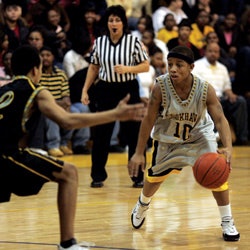An Ohio school district's blueprint for reigning in student transfers practically eliminates moving violations.

So in August 2005, Rotonda and his staff - armed with thousands of student records - set out to determine how many students were taking advantage of the district's open-transfer policy. What they discovered astonished even a hardened veteran like Rotonda: Approximately 1,700 of the 16,000 or so students in grades 10 through 12 registered at a Columbus public high school during the 2004-05 academic year were enrolled at a different Columbus public high school the previous year.
"It might have actually been more than that, but that's how many we found," Rotonda says. "We're just talking about three grade levels. That's a huge annual migration of talent and people. We were aware of the problem, but not the magnitude of it. I think it's fair to say that most of those transfers were academically motivated, but a student always had to say a move was for academic reasons - even though we saw athletes moving for athletic reasons."
Now, thanks to a strict transfer policy introduced in October 2005, Columbus has drastically reduced the yearly number of transient student-athletes to double digits. Between June 2006 and early January 2007, only 25 athletic transfers had been approved by meeting one of four eligibility exceptions: a bona fide family move, an academic program move, a clerical placement error or a superintendent's determination that an individual would be better served in another school. If a student-athlete transfers for any other reason, he or she will forfeit an entire calendar year of competition. (Rotonda's office no longer keeps track of non-athletic transfers.)
The intradistrict transfer rule in Columbus is similar to the one that will take effect Aug. 1 at all Ohio High School Athletic Association member schools, and it serves as a practical model for other multiple high school districts with touchy transfer-eligibility issues. "There is no such thing as a panacea in interscholastic sports," says Deborah Moore, the OHSAA's assistant commissioner who oversees eligibility issues. "But this certainly will cut down on the transfers."
Illegal transfers and related recruiting violations have been part of the prep sports landscape for decades. In recent years, however, officials at state associations around the country have done their best to make athletic directors, principals and even guidance counselors aware of what's at stake. Student-athletes who jump schools for reasons other than academics open up themselves, their teams and their new schools to penalties that can range from varying lengths of ineligibility periods for the player and probationary periods for his or her school to hefty fines, game forfeitures and tournament disqualifications. From an educational perspective, moreover, it's not widely viewed as a healthy practice.
"Academically, a child who stays in the same high school does better than a child who moves around two, three or four times," Rotonda says. "So moving kids around is not something to be encouraged, and in effect, we were doing that. Or, I should say, we weren't doing anything to discourage it."
Late last year, USA Today reported that 25 of the 51 state high school associations have within the past three years modified, or began modifying, policies to close loopholes in their transfer rules. "There was a lot of evidence in some of our multiple high school districts of kids being transferred and appearing on basketball and football teams that win championships," Moore says, explaining the need for OHSAA's new intradistrict transfer policy, which will only affect 39 of the state's 612 public school districts - but will likely do so in significant ways, especially in major metropolitan areas like Cleveland and Cincinnati. "It just seemed that those students have additional privileges that kids in single high school districts simply do not have. The potential for developing power schools in certain sports was a big concern."
In addition to providing the same eligibility exceptions as Columbus' intradistrict transfer rule, OHSAA's new policy (already in the works when Rotonda pitched his proposal back in 2005) will also include provisions for court-ordered changes of custody, school closings, relocation of disability programs and students deemed to be moving from an unsafe or poor-performing school. The new policy supersedes the state's lenient practice of allowing students to transfer with nothing more than a superintendent's signature, which Moore admits was often treated as a mere formality. "That has been one of the problems," she says.
Back in Columbus, the impact of transfer restrictions is already being felt. "Those schools that had benefited from open enrollment have seen a noticeable decline in their powers," Rotonda says. "Those schools that have traditionally built their programs one kid at a time from their own population haven't fallen as far."
Columbus' transfer rule has helped curb discipline problems among student-athletes, too. If a troublemaker is transferred from one school to another at the district's discretion, he or she will suffer the same ineligibility penalty as intradistrict transfer rule violators. "It has given us another tool to work with regarding kids who may be on the fringes because of misbehavior," Rotonda says. "We can say, 'If you keep going down this path and we assign you to a different high school, you're going to get splinters for a year.' "
Rotonda involved OHSAA representatives, athletic directors, high school principals, special-education teachers and curriculum directors in the process of what he calls "The Columbus Plan." He even held a forum between ADs in his office to weigh the pros and cons of his proposed policy.
"I took some shots," Rotonda admits, referring to coaches and ADs who threatened legal action against Columbus Public Schools for even considering transfer restrictions. "But the bottom line is that it was a good thing to do. I feel a lot better now that there is a level playing field."




































